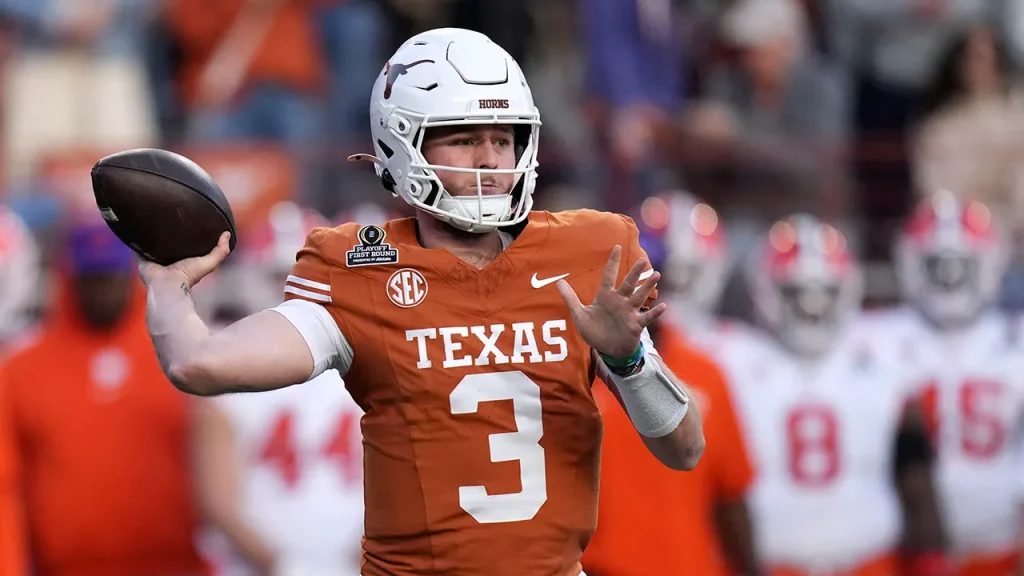The 2025 NFL Draft quarterback landscape is poised for a potential shake-up with the possible entry of Texas Longhorns quarterback, Quinn Ewers. While not officially declared, Ewers’ response to ESPN’s Pete Thamel, stating he doesn’t expect to play college football next year, strongly hints at his intentions to forego his remaining college eligibility and pursue a professional career. This unexpected development adds another layer of intrigue to an already anticipated quarterback class, leaving many to speculate about Ewers’ future and the implications for both the Longhorns and the NFL draft. Adding to the complexity of the situation is a reported $6 million NIL (Name, Image, and Likeness) offer from another unnamed school, dangling the possibility of a lucrative transfer for the 2025 season should Ewers choose to remain in college football. This offer underscores the evolving dynamics of college athletics and the significant financial incentives now available to student-athletes.
Ewers’ potential departure comes after a season marked by both promise and challenges. While he’s thrown for more touchdowns this season compared to last, his overall statistical performance has dipped, with fewer passing yards and a higher interception rate. An injury mid-season further complicated matters, providing an opportunity for highly touted freshman Arch Manning to showcase his skills. Manning’s emergence, albeit primarily as a rushing threat, has added another dimension to the Longhorns’ offense while simultaneously raising questions about the long-term quarterback situation in Austin. Despite the fluctuating performance and the looming presence of Manning, Ewers remains the starting quarterback for Texas, leading them into a high-stakes Cotton Bowl Classic matchup against the Ohio State Buckeyes.
The Cotton Bowl presents a pivotal moment for Ewers and the Longhorns. A victory would propel them into the national championship game against Notre Dame, offering Ewers a chance to solidify his legacy and potentially boost his draft stock. However, the looming decision regarding his future undoubtedly adds pressure to the already intense atmosphere surrounding the game. Ewers’ performance against a formidable Ohio State defense could significantly influence his final decision, providing a valuable opportunity to demonstrate his capabilities on a national stage. The pressure to perform, coupled with the swirling speculation about his future, creates a compelling narrative around the young quarterback.
The uncertainty surrounding Ewers’ future is further fueled by the dynamics within the Texas football program. Head coach Steve Sarkisian faces a delicate balancing act between supporting his current starting quarterback and developing the highly touted Manning. While Ewers is currently at the helm, the arrival of Manning signals a potential shift in the quarterback hierarchy, creating a sense of urgency for Ewers to prove his worth. Some analysts suggest that Sarkisian has extended a longer leash to Ewers this season, perhaps acknowledging the potential transition to Manning in the near future. This dynamic adds another layer of complexity to Ewers’ decision-making process, as he weighs his immediate future against the long-term prospects at Texas.
The interplay of these factors – Ewers’ fluctuating performance, Manning’s emergence, the lucrative NIL offer, and the pressure of the Cotton Bowl – creates a captivating storyline. Ewers stands at a crossroads, with multiple potential paths unfolding before him. He could declare for the NFL draft, capitalizing on his existing potential and the current buzz surrounding his name. He could accept the reported $6 million NIL offer and transfer to another program, seeking a fresh start and a potentially more prominent role. Or he could remain at Texas, battling for the starting position against Manning and striving to lead the Longhorns to a national championship. Each option presents its own set of risks and rewards, making Ewers’ decision one of the most intriguing storylines in college football.
The outcome of the Cotton Bowl Classic and Ewers’ subsequent decision will have significant ramifications for both his career and the landscape of college football. A strong performance in a high-stakes game could solidify his NFL prospects, while a less-than-stellar outing might influence him to consider other options. Regardless of his choice, Ewers’ story underscores the transformative changes within college athletics, where NIL deals and the allure of professional sports create complex decisions for young athletes. The coming weeks will provide clarity on Ewers’ future, but for now, his situation remains a compelling case study in the evolving world of college football.

